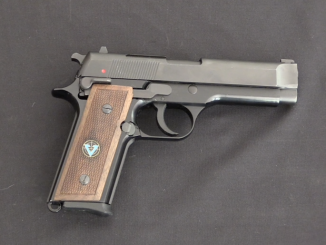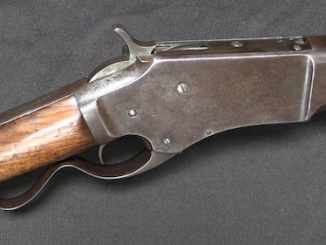This is lot #3220 in the upcoming RIA Premier Auction. It was scheduled for April, but has been postponed – check their web site for upcoming Online Only auctions every month, though!
The Model 1871 Ward-Burton was one of the early experimental rifles trialled by the US military in its search for a new breechloading rifle to replace the theoretically-interim Allin conversion that made muzzle-loading rifles into Trapdoor Springfields. Four breechloading cartridge rifles were selected for field trials in the early 1870s: the Sharps, the Trapdoor Springfield (as a control), the Remington Rolling Block, and the Ward-Burton bolt action. It was a single-shot design, and the only one of the trial designs that would not have already been relatively familiar to US troops at the time. While the bolt action system is ubiquitous today, it was quite novel in the 1870s.
Mechanically, the Ward-Burton was fairly standard by today’s standards, although it used two sets of interrupted threads at the rear of the bolt for locking, rather than the two large front lugs preferred today. The names associated with it are two US Generals, William Ward and Bethel Burton. Ward held a patent on the bolt action system the rifle used (US Patent 81,059), and Burton held a patent on the extractor/ejector mechanism (US Patent 99,504). In total, 1013 Ward-Burton rifles (32 1/8″ barrel) and 313 carbines (22″ barrel) were manufactured by Springfield chambered for the then-standard .50-70 cartridge, and issued to a variety of units. These included the 13th Infantry and 1st, 3rd, 4th, 5th, 6th, 7th, and 9th Cavalry companies.
Ultimately, of the 95 field reports filed on the different rifles in these trials, not a single one recommended the Ward-Burton for adoption. The guns had a few mechanical issues (including heat treat problems with the bolts), but more significant seems to have been the general unfamiliarity of the bolt system with troops. The Trapdoor Springfields, Rolling Blocks, and Sharps rifles all had vary prominent manually-cocked hammers that would clearly communicate whether the rifles were ready to fire. The Ward-Burton bolt had a modern-type internal striker, and no obvious outward indication of loaded/unloaded/cocked/uncocked status. This led to soldiers being uncomfortable with the guns, and more than a few accidental discharges. This would not be such an issue today, I suspect, but it was enough to prevent the Ward-Burton from seeing any further use by the US military at the time.




That extractor has a very Mauser-like look to it. I have always favored the cock-on-closing designs for their ease of decocking the striker spring. Even designs like the Remington that are not cock-on-closing but are based on cock-on-closing designs do this.
Clearly Rock Island is selling a magnificent, world heritage status, collection of U.S. rifle trials guns; because the bloke that collected them has died; and none of his family want to. or can agree on, keeping it as a collection. As I have said before: forgottenweapons’ recording of this kind of thing is a massive addition to the primary history of guns.
Clearly, several soldiers suffered the accident of “Oh no, I just shot Alfred in the knee!!” This is the same problem for any breech-loading rifle (especially one with a magazine of cartridges) that cannot de-cock (whether by hammer or lever) or be set to safe by a switch. Having a loaded chamber and forgetting that it’s loaded generally leads to a limping Alfred (or a DEAD one). Just kidding…
The British trials which led to the adoption of the Martini, stopped all testing of bolt actions, after a tester was seriously injured by an out of battery discharge from a Bacon bolt action.
The tester was injured while loading it, he was not in front of it.
I’ve never had the opportunity to get a good look at a Bacon bolt action. The patents look interesting, but I can’t unambiguously work out what they are describing. The interior of the bolt looks very interesting.
The British army mandarins took their experiences at the trials, as a universal condemnation of anything and everything bolt action – for many years afterwards, all bolt actions were regarded as being intrinsically unsafe.
Interestingly, Bacon had several very nice side by side double shotguns made with his patented bolt action, each one with a pair of mirror image bolts.
I only realised a few weeks ago that Ian has reviewed another double barrel shotgun, based on another action from those trials- an over and under “Money-walker” ( I know I’ve spelled the name “money” incorrectly).
Anyway – early bolt actions were widely perceived as being intrinsically unsafe (and many of them probably were!)
Quite how much of that prejudice resulted in the reaction by designers, in incorporating, big, heavy, fugly cooking pieces onto the back of the firing pin – I’m not sure
But, big fugly cocking pieces made it right into the war to make a world safe for stalin, Mao, pol pot…. and beyond
“(…)accident(…)”
Crucial question here is: do you want to design gun for users habits or you are ready to train users to given design?
As comparison in similar time when Ward Burton rifle was tested, Dutch adopted BEAUMONT rifle: http://www.militaryrifles.com/holland/Beaumont.htm
it was used for many years to follow, despite it what probably result in similar judgement from testers of Ward Burton rifle.
“(…)Four breechloading cartridge rifles were selected for field trials in the early 1870s: the Sharps, the Trapdoor Springfield (as a control), the Remington Rolling Block, and the Ward-Burton bolt action.(…)”
I found Berdan missing from that competition: https://en.wikipedia.org/wiki/Berdan_rifle
what was Hiram Berdan doing at that time?
Maybe Berdan figured the army would reject his bolt action design as too different. Plus he had a good market with the Russians, considering they would make 3 million of them.
Berdan was out of the country. He went to Russia in 1869 and then traveled in Europe, not returning to the United States until 1886.
Old monkeys can still learn new tricks.After Keith mentioned using
the big fugly piece as a decocker I grabbed my Gras rechambered in 16G and tryed decocking it while my thumb controlled the cocking piece. It works very well I usually decock it by holding down on the trigger lifting the bolt handle and letting it down gently
This was left over from when I was a lad shooting chucks in S. W. Ontario. My dad didnt trust the safty on his M75 22cal winchester
He always made me decock it when it had a bullet in the chamber by lifting the bolt handle pulling the trigger and letting the bolt down gently. As there was no cocking piece on the winchester bolt this was what I thought you did for all bolt guns
And of course for most bolt actions (and most other rifles that can be gotten that way) chamber loaded/bolt decocked is quite an unsafe way to carry them.